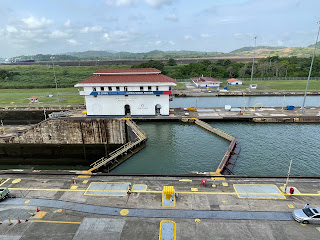Last year, museums, tourist sites, and even the historic district of Casco Viejo seemed a bit empty, but they’re getting more lively now. The outdoor mask mandate was lifted on March 28, although the majority of people on the street still wear them. The indoor mask mandate was lifted for the first time on July 11.
Casco Viejo sits on a peninsula heavily damaged by the 1989 U.S. military invasion that removed Manuel Noriega from power. It was named a UNESCO World Heritage site in 1997, which drew considerable investment by developers who are faithfully restoring the Spanish Colonial architecture of the buildings.
 |
| Panama's National Theater |
The district (also called Casco Antiguo or San Felipe) is the site of the presidential compound, National Institute of Culture, and several centuries-old churches. It’s now a tourist hotspot as well, with high-end restaurants, cafes, boutique hotels, and rooftop bars. David stops daily at Nomada, one of several good coffee shops in the neighborhood.
The narrow brick streets of Casco Viejo lead past several public plazas with shady trees, including the lively Plaza Herrera with lots of outdoor dining. At one end of the district is the French monument to the canal with an amazing view of the city. We saw an orchestra perform at the ornate Teatro Nacional, which was recently renovated.
Panama was originally established northeast of the city in 1519, on a site now called Panama Viejo. The old city was burned to the ground in 1671 by the dread pirate Capt. Henry Morgan—now a brand of rum. In March we went to La Ciudad de Piedra, a festival in the stone ruins with a live performance about Panama’s history.
Today, the country is most famous for the Panama Canal, a 50-mile channel opened by the U.S. in 1914 connecting the Atlantic and Pacific oceans. A treaty signed by President Carter turned over full control of the canal zone to Panama on Jan. 1, 2000.
 |
| Miraflores Locks |
From our balcony we can see the “parking lot” of giant container ships waiting in the bay to enter the canal, which takes an average of 8 to 10 hours to transit. The visitor’s center at the Miraflores locks has a spectacular observation deck for watching the ships up close.
Panama also is famous for its beaches, but there are no swimming beaches in the city itself; the embankment is rocky and the water is murky, polluted, and we’ve seen saltwater crocodiles. The nicest beach closest to the city is a 30-minute ferry ride to Taboga Island, while the most beautiful white sand beaches are on the (harder to reach) San Blas chain of islands on the Atlantic side.
 |
| Waiting for the boat on Isla Perro Chico in San Blas |
Over the New Year’s holiday we rented a house on Carenero Island in the Bocas del Toro province of Panama, which is an archipelago in the Atlantic bordering Costa Rica with spectacular crystal-clear turquoise water.
Just over the Bridge of the Americas (at the Pacific entrance of the Panama Canal) is the Westin Playa Bonita resort, which has a decent beach at high tide. Down the road from there is the small beach town of Veracruz, which has a row of thatch-roofed restaurants overlooking the ocean with gorgeous views. Our favorite there is Praia.

Wow what an adventure! Give my love to Dave, wish you both all the best.
ReplyDelete